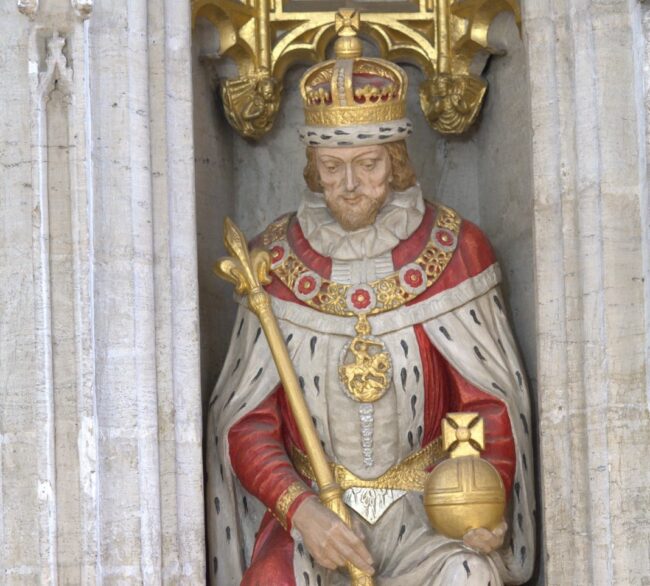Royals Map

Edward II

Edward II's coat of arms can be seen here in the medieval stained glass. Nearly all the glass in the cathedral was damaged during the Reformation and Civil War so very little remains. This window has been restored using fragments of recovered medieval glass.
Edward II also called for Parliament to sit in Ripon in 1322 to avoid plague in London, but in the end York was chosen instead.
b.1284 - d.1387
Photo Judith Hooper
Charles I

Charles I came to Ripon Cathedral (then a minster) to sign a treaty with the Scots in 1640. He would have been entertained in the minster and in a minister's house.
He was also brought here as a prisoner in 1646 after the English Civil War.
b. 1600 - ex. 1649
Etheldreda

Etheldreda was a daughter of King Anna of East Anglia. She married twice, her second husband being King Ecgfrith of Northumbria. He was only fifteen when they wed.
Throughout both marriages she remained a virgin as chastity was thought to be true devotion to Christianity. Originally Ecgfrith agreed with this but some years later he is said to have wanted a normal marital relationship.
Etheldreda went to Wilfrid, her spiritual adviser, and with his counsel, she refused her husband, left her marriage and became a nun.
Eltheldreda founded Ely Abbey, a double monastery for monks and nuns in 673. Ely Cathedral now sits on the same site.
Hild

Hild was Abbess of Whitby, a powerful religious centre in the Anglo-Saxon world.
She was the great niece of the Northumbrian king Edwin, and she was raised in his court after her father was murdered.
Hild hosted the Synod of Whitby in 664, which Wilfrid attended as Bishop of Northumbria. Northumbria was still following mainly Celtic traditions, even though the rest of the western Church had adopted the Roman style. The Synod of Whitby was called to sort out whether Northumbria should calculate the date of Easter by the Celtic or Roman method.
Hild appeared to favour the Celtic way, whereas Wilfrid proposed adopting the Roman method. At the Synod in 664, King Oswiu of Northumbria ruled in favour of Wilfrid and Roman tradition.
Legend has it that Whitby was plagued by snakes, and Hild prayed to God that their heads be removed and they be turned into stone. Hild's carving on the pulpit has a shield with three snakes to represent this.
b. 614 – d. 680
James I

This statue shows beautifully the costume of the early Stuart period. It is contemporary, created in about 1620 for York Minster.
This James I was in York Minster until 1810 when it was removed to make way for a new King Henry VI statue. James I was donated to Ripon Cathedral by the Dean and Chapter of York at this time.
Photo Judith Hooper
Royal coat of arms

This is the Royal Coat of Arms belonging to James I. All parish churches had one of these, but few also contained any writing. The inscription underneath translates as "Blessed are the Peacemakers". Unusually, this coat of arms is also double sided.
Can you find reference to James I anywhere else?
Jubilee Chairs

These chairs, now set in the sanctuary of St Peter's Chapel, were to commemorate the Silver Jubilee of Queen Elizabeth II in 1977.
They have been used by royalty when the Queen came to Ripon Cathedral for the Maundy service and to distribute Maundy money in 1985.
Now, they are primarily used in weddings for the bridal couple to sit in after the signing of the register.
Photo Judith Hooper
Eanfled

Queen Eanfled was a Saxon queen married to King Oswig of Northumbria.
She was instrumental in Wilfrid getting an education as a boy and she helped him with his first trip to Rome. Wilfrid visited Rome and Europe several times and these trips inspired him to create the crypt here at Ripon.
Eanfled was a close advisor to Wilfrid throughout her married life. After her husband King Oswig died in 670 AD Eanfled retired to Whitby Abbey and ultimately became abbess there with her daughter.
Eanfled is portrayed in the bottom left corner of the window in St Wilfrid's chapel.
b. 626 - d. 704
Athelstan

Athelstan or Aethelstan is generally regarded as the first King of England.
He established a treaty with the then king of York, Sihtric in 926, and when Sihtric died the following year, a few more battles (not in York) led to the completion of the reconquest. Athelstan, however, claimed it to be from the moment when peace was established in 926.
In 926 Athelstan also established the Liberty of St Wilfrid: an area of one mile radius around the minster at Ripon that offered shelter to all and was outside royal authority.
b.894 – d.939 AD
Photo Judith Hooper
Henry II

Henry II was the monarch at the time of the Archbishop of York Roger de Pont l'Évêque.
Roger rebuilt much of Ripon Cathedral after the "Harrying of the North" by William the Conqueror a hundred years before. The current Chapter House, Library and the transepts were all built by Roger around 1180.
Henry II asked Roger to crown his son in 1170 because of a dispute between Henry II and Thomas Beckett, the Archbishop of Canterbury. Thomas excommunicated Roger for this and Roger is implicated in Thomas's murder shortly after, supposedly at the wishes of Henry II.
b.1133 – d.1189
Photo Judith Hooper
James I

James I was the successor to Elizabeth I and the first King of England and Scotland.
In 1604 James I granted a charter to Ripon for worship. His charter created a "collegiate church" consisting of a Dean and six canons, six lay clerks (adults) and six choristers (children).
James I also granted a second charter to Ripon which created the Mayor and allowed for independent local governing.
b.1566 — d.1625
Photo Judith Hooper